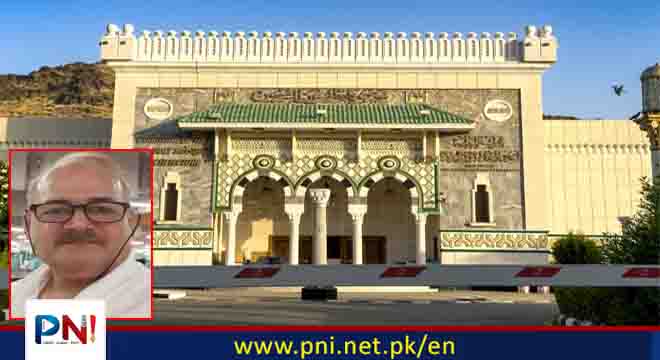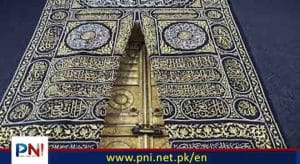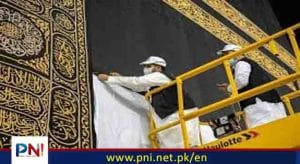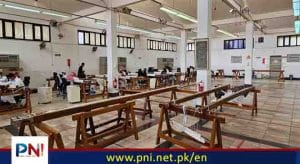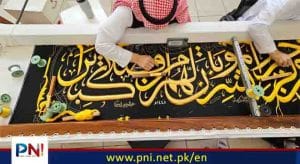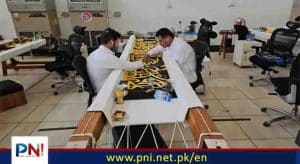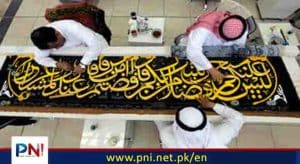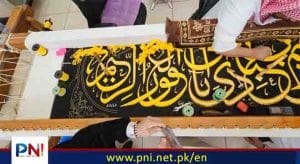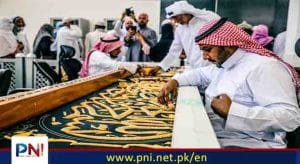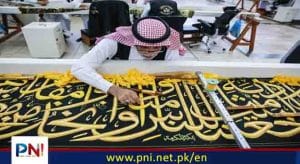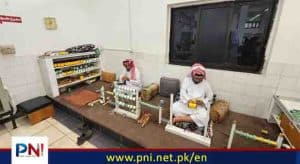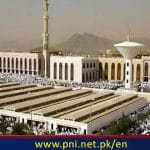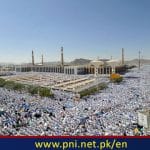New black, pure-silk clothing for Kaaba, called kiswa, is made by the Kiswa Factory of the Holy Kaaba (King Abdulaziz Complex) every year. It is embroidered with silver wires painted with glittering gold, with which Quranic verses and supplications are written. The clothing is used to cover “The Ancient House” (another name for Kaaba) to which Muslims’ hearts are attached.
History of Kiswa Factory:
Saudi Arabia has paid great attention to kiswa since the reign of the Founding King, Abdulaziz ibn Abdulrahman Al-Saud. In 1927, a special workshop for making kiswa was established, producing the first Saudi clothing. However, in 1977, it was replaced by the Kiswa Factory, located in Om Al-Joud, Makkah.
King Abdulaziz’s sons also showed great interest in the kiswa; during the reign of King Abdullah ibn Abdulaziz Al-Saud, electronic systems, advanced equipment and electronic devices were employed in the process. During the reign of King Salman ibn Abdulaziz Al-Saud, the name was changed to “King Abdulaziz Complex for Kiswa, and it is currently supervised by the General Presidency of the Grand Mosque and the Prophet’s Mosque.
Changing the kiswa:
Muslims used to look forward to seeing the ceremony of changing the kiswa on Dhu Al-Hijja, 9, after al-Fajr prayer. However, in 1444 Hijri/2022 AD the date was changed to Muharram 1.
Introduction to Kiswa:
The Kiswa of the Kaaba is a magnificent cloth covering that adorns the holiest shrine in Islam, the Kaaba, located in the city of Mecca, Saudi Arabia. It holds immense religious and historical significance, serving as a visual representation of the unity and sanctity of the Muslim community worldwide. This article explores the detailed history, design, production, and significance of the Kiswa, shedding light on its rich cultural and religious heritage.
Historical Background:
The history of the Kiswa dates back to the time of Prophet Muhammad (peace be upon him) and the early Islamic period. According to Islamic history, the Kaaba was originally built by Prophet Abraham (AS) and his son Prophet Ishmael AS) as a monotheistic place of worship. Over the centuries, the Kaaba went through several reconstructions and renovations, and the tradition of covering it with a cloth emerged.
Design and Construction:
The Kiswa is a large black cloth that entirely envelops the Kaaba. It is made from high-quality silk, which is dyed black and intricately embroidered with gold thread. The embroidery typically consists of Quranic verses, floral patterns, and calligraphic inscriptions. The fabric itself is produced in specialized textile factories, and the embroidery is carried out by skilled craftsmen.
Production Process:
The production of the Kiswa is a meticulous and time-consuming process. It begins with the procurement of high-quality silk, which is then woven into large sections of fabric. These fabric sections are then sent to skilled artisans who meticulously embroider the verses from the Quran, intricate patterns, and calligraphic designs onto the cloth. The embroidery is often done by hand, using traditional techniques passed down through generations.
Annual Replacement Ritual:
Each year the Kiswa is replaced with a new one in a ceremony known as “Ghusl al-Kaaba.” The old Kiswa is removed and cut into small pieces, which are often distributed as blessed mementos to dignitaries, scholars, and charitable organizations. The new Kiswa is then carefully placed and secured around the Kaaba.
Symbolism and Significance:
The Kiswa carries profound symbolism and significance within the Islamic faith. It represents the unity of Muslims worldwide, as it serves as a visual reminder of their common devotion to Allah. The black color of the Kiswa symbolizes simplicity, humility, and the equality of all Muslims before God. The embroidered verses from the Quran remind Muslims of the sacred teachings and serve as a source of inspiration and contemplation.
Cultural and Historical Heritage:
The Kiswa is not only a religious artifact but also a cultural and historical treasure. Its craftsmanship, intricate embroidery, and exquisite design reflect the artistic traditions of the Islamic world. The production of the Kiswa has been a continuous tradition for centuries, providing a link to the past and connecting generations of Muslims.
Conclusion:
The Kiswa of the Kaaba stands as a remarkable symbol of faith, unity, and devotion in the Islamic world. Its elaborate design, meticulous production process, and annual replacement ritual all contribute to its significance and cultural heritage. The Kiswa serves as a powerful reminder of the timeless traditions and values that form the foundation of the Islamic faith, making it a cherished and revered artifact for Muslims worldwide.
Follow the PNI Facebook page for the latest news and updates.


